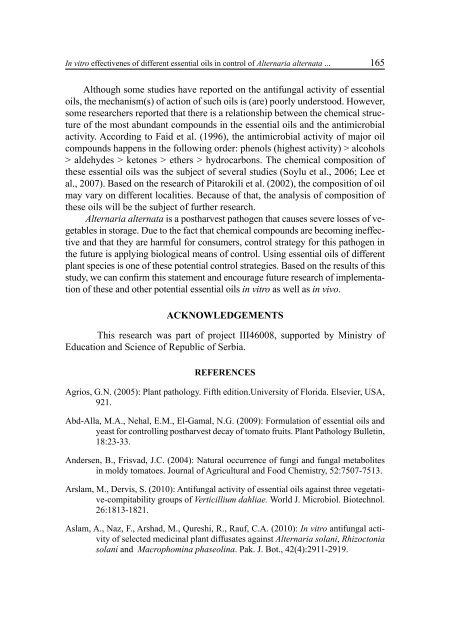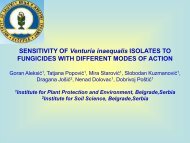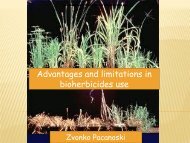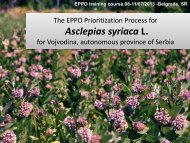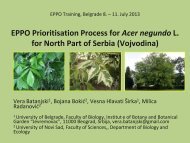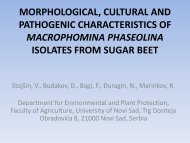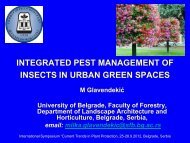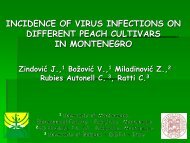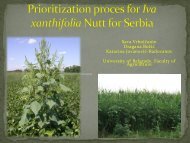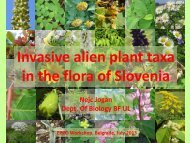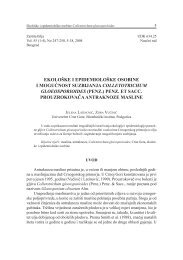ZAŠTITA BILJA PLANT PROTECTION
Vol.62 (3) - Izbis
Vol.62 (3) - Izbis
You also want an ePaper? Increase the reach of your titles
YUMPU automatically turns print PDFs into web optimized ePapers that Google loves.
In vitro effectivenes of different essential oils in control of Alternaria alternata ... 165<br />
Although some studies have reported on the antifungal activity of essential<br />
oils, the mechanism(s) of action of such oils is (are) poorly understood. However,<br />
some researchers reported that there is a relationship between the chemical structure<br />
of the most abundant compounds in the essential oils and the antimicrobial<br />
activity. According to Faid et al. (1996), the antimicrobial activity of major oil<br />
compounds happens in the following order: phenols (highest activity) > alcohols<br />
> aldehydes > ketones > ethers > hydrocarbons. The chemical composition of<br />
these essential oils was the subject of several studies (Soylu et al., 2006; Lee et<br />
al., 2007). Based on the research of Pitarokili et al. (2002), the composition of oil<br />
may vary on different localities. Because of that, the analysis of composition of<br />
these oils will be the subject of further research.<br />
Alternaria alternata is a postharvest pathogen that causes severe losses of vegetables<br />
in storage. Due to the fact that chemical compounds are becoming ineffective<br />
and that they are harmful for consumers, control strategy for this pathogen in<br />
the future is applying biological means of control. Using essential oils of different<br />
plant species is one of these potential control strategies. Based on the results of this<br />
study, we can confirm this statement and encourage future research of implementation<br />
of these and other potential essential oils in vitro as well as in vivo.<br />
ACKNOWLEDGEMENTS<br />
This research was part of project III46008, supported by Ministry of<br />
Education and Science of Republic of Serbia.<br />
REFERENCES<br />
Agrios, G.N. (2005): Plant pathology. Fifth edition.University of Florida. Elsevier, USA,<br />
921.<br />
Abd-Alla, M.A., Nehal, E.M., El-Gamal, N.G. (2009): Formulation of essential oils and<br />
yeast for controlling postharvest decay of tomato fruits. Plant Pathology Bulletin,<br />
18:23-33.<br />
Andersen, B., Frisvad, J.C. (2004): Natural occurrence of fungi and fungal metabolites<br />
in moldy tomatoes. Journal of Agricultural and Food Chemistry, 52:7507-7513.<br />
Arslam, M., Dervis, S. (2010): Antifungal activity of essential oils against three vegetative-compitability<br />
groups of Verticillium dahliae. World J. Microbiol. Biotechnol.<br />
26:1813-1821.<br />
Aslam, A., Naz, F., Arshad, M., Qureshi, R., Rauf, C.A. (2010): In vitro antifungal activity<br />
of selected medicinal plant diffusates against Alternaria solani, Rhizoctonia<br />
solani and Macrophomina phaseolina. Pak. J. Bot., 42(4):2911-2919.


